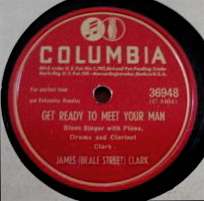Look on Yonder Wall
"Look on Yonder Wall", or "Get Ready to Meet Your Man" as it was first named, is a blues song first recorded in 1945 by James "Beale Street" Clark. Clark, also known as "Memphis Jimmy", was a blues pianist from Memphis, Tennessee. During the 1940s, he appeared on recordings by Jazz Gillum, Red Nelson (also known as Dirty Red), and an early Muddy Waters session, as well as several singles in his own name.
| "Get Ready to Meet Your Man" | |
|---|---|
 | |
| Single by James "Beale Street" Clark | |
| B-side | "Love Me or Let Me Be" |
| Released | 1945 |
| Format | 10-inch 78 rpm record |
| Recorded | October 24, 1945 |
| Genre | Blues |
| Label | Columbia |
| Songwriter(s) | James Clark |
In 1961, Elmore James adapted the song, titled "Look on Yonder Wall", which was issued as single. Most subsequent renditions show James's influence.
Origins
"Look on Yonder Wall" was performed as a mid-tempo twelve-bar blues, with a recurrent post-World War II theme.[1] It tells of a "man who is somewhat disabled and has not been drafted and takes advantage of that to entertain lonely married women".[1] When the husband is discharged, the narrator ponders his fate:
Now baby I've been worried, ever since victory day
Every time I pick up the paper, your man is comin' this a way
Look on yonder wall, hand me down my walkin' cane
Jazz Gillum, with whom the song is often associated, recorded a version on February 18, 1946, (RCA Victor 20-1974), four months after Clark. Although the release was retitled, it credits "James Clark" as the composer.[2] Other early versions include Arthur "Big Boy" Crudup as "Hand Me Down My Walking Cane" (1950, RCA 22-0100) and Boyd Gilmore as "Just an Army Boy" (1950, Modern 860).
Elmore James version
In 1961, Elmore James recorded his version as "Look on Yonder Wall" for Bobby Robinson's Fire Records.[3] The session took place at Cosimo Matassa's J&M Studios in New Orleans, Louisiana.[4] Backing James on vocal and guitar are Sammy Myers on harmonica, Johnny "Big Moose" Walker on piano, Sammy Lee Bully on bass, and King Mose on drums.[3] The song is one of the few Elmore James songs to feature harmonica,[5] as he typically used saxophone.
Fire released the song as the flip side of "Shake Your Moneymaker" in 1961.[3] It was one of the last singles of new material released before James's death in 1963. Most artists who recorded the song after James follow his arrangement, such as Junior Parker (1962, Duke 367), Junior Wells with Buddy Guy (1965, Hoodoo Man Blues), and Paul Butterfield (1965, The Paul Butterfield Blues Band).
A related song is "Boot Hill",[6] of which relatively little is known. Johnny Winter and Stevie Ray Vaughan each recorded versions for their respective albums Guitar Slinger (1984) and The Sky Is Crying (1989, released 1991). The lyrics for "Boot Hill" are more ominous than the earlier variations: "Look on yonder wall, hand me down my walkin' cane" is rendered "Look up on the wall baby, hand me down my shootin' iron".[6]
References
- Herzhaft, Gerard (1992). "Look Over Yonder's Wall". Encyclopedia of the Blues. University of Arkansas Press. p. 459. ISBN 1-55728-252-8.CS1 maint: ref=harv (link)
- van Rijn, Guido (2006). The Truman and Eisenhower Blues. Continuum. p. 157. ISBN 978-0-8264-9068-1.CS1 maint: ref=harv (link)
- Haig, Diana; Morris, Chris (1992). King of the Slide Guitar (Box set notes). Elmore James. Capricorn Records. OCLC 26833148. 9 42006-2.CS1 maint: ref=harv (link)
- Franz, Steve (2003). The Amazing Secret History of Elmore James. Walsworth Publishing. pp. 115–117. ISBN 0-9718038-1-1.CS1 maint: ref=harv (link)
- "Dust My Broom", Elmore James' first single, featured harmonica by Sonny Boy Williamson II (1951 Trumpet 146).
- "Stevie Ray Vaughan". CD Review. Vol. 8 no. 1–6. 1991. p. 134. ISSN 1041-8342.CS1 maint: ref=harv (link)